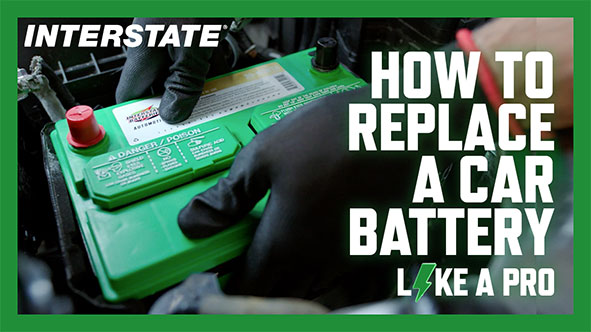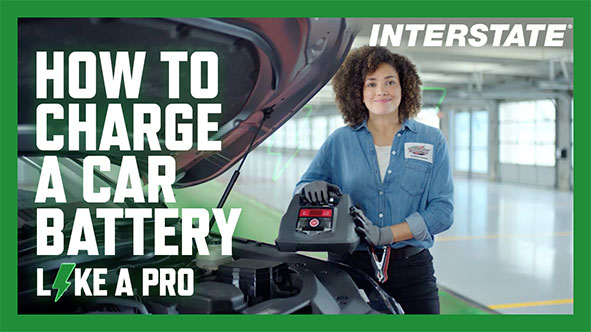Our PROs Are Never Hard To Find
Buscar un punto de venta
- Cerrado
- Comuníquese con la tienda para conocer el horario de atención
The Battery Mechanics Prefer
Interstate batteries are sold at more locations and are the preferred choice of auto technicians. With so many authorized dealer locations, there’s always one close by. Let our trusted pros help.
Cómo prevenir una batería descargada con un clima frío
The colder the weather gets, the weaker car batteries become. Even a strong, fully charged car battery won’t feel 100% if the temperatures drop enough. If your car battery is only half-charged? It’ll freeze solid at just minus 10 F. If you live in Canada, the Dakotas, Minnesota, or Wisconsin, you’ve probably seen a few frozen batteries. Cold snaps and wintery mixes threaten battery life in every car.
And you rely on your car battery in the winter.
Holiday dinners, parties, visiting grandmothers who live over rivers and through woods — you’ve got places to be, family to hug, and eggnog to sip. Here’s the problem: es posible que se dé cuenta de que su batería está descargada cuando tenga que ponerse en marcha.
1. Haga revisar su batería automotriz.
Es simple y fácil, y suele ser gratis en los talleres de reparación en toda Norteamérica.
Drive to your closest Interstate Batteries authorized dealer and ask for a car battery test. They’ll use their tester to look for any weakness in your car battery – and even tell you the temperature that’ll kill the battery section.
Then you can pick where and when to deal with your new car battery, instead of a dead battery demanding you deal with it right then.
2. Keep driving for 10 minutes or longer.
El siguiente consejo para evitar problemas en la batería en invierno: conducir.
Driving every day keeps the damage of cold weather at bay. Your engine warms the car battery when you drive to and keeps your battery healthy.
Esta es una regla de oro: conduzca la duración de su viaje diario, aún de vacaciones.
The average commutes for Americans and Canadians are longer than 20 minutes one way, according to census data from the U.S. Bureau of Statistics and Statistics Canada. Making a similar drive — to a café, the in-laws, or even a grocery store on the far end of town — can keep your battery healthy and ready.
However, the moment your car seems slow to start, it’s time to get to a repair shop. That’s an early sign your car battery is going to die. And driving won’t help bring a dead battery back to life.
3. Estacione su automóvil en un garaje siempre que sea posible.
Ambient temperatures during cold weather can kill your battery. Por este motivo, mejor estacione en estos lugares:
- En su garaje
- En garajes de estacionamiento con mucho tráfico de entrada y salida
- Cerca de equipos que tengan altas temperaturas
- Cerca de edificios cálidos
- En espacios con mucha luz solar directa para que la carrocería del automóvil permanezca caliente
- En cualquier lugar donde pueda estar más expuesto al calor que a la intemperie y a las bajas temperaturas
¿Qué tan caliente tiene que estar? It depends on how weak your car battery already is. The weaker your battery, the warmer it has to be to ensure you can start your car. It depends on your battery’s size, power, and age.
The battery’s polypropylene plastic case offers thermal protection, too. Its internal design and material structure keep the water-acid mixture (electrolyte) about 5 degrees warmer. But the more discharged the battery, the thinner the mixture is. At 10% charge, the liquid inside is mostly water — but even then, water in the polypropylene case won’t freeze solid until temperatures drop to 28 F.
A fully charged battery can resist incredibly cold temperatures. (The thermometer has to read minus 80 F to freeze a fully charged battery!) But that strength disappears if your battery wears down enough. If your battery is only half-charged, it could turn to a block of ice at minus 10 F overnight. But, odds are, your battery-popsicle would have failed your car long before the temperature fell that low.
4. Envuelva su batería automotriz en una cubierta térmica.
Battery warmers, insulators, electric battery blankets, thermal wrap — they go by many names, but they’re all corrosion-resistant heat blankets for your battery. Están disponibles en línea o en tiendas.
In a pinch, you can throw a dry, thick bath towel on the battery, after you’ve driven enough, to warm the engine. As soon as you park, pack the towel onto the battery. The extra coating will retain the engine heat. Definitely be sure to remove the towel before you start the engine again!
Most carmakers already give your battery extra coating. But most amateur mechanics who replace their own car batteries will often trash the protective battery coating.
Expert advice: Don’t want a frozen battery? Don’t trash your car battery protection.
Buscar un punto de venta
- Cerrado
- Comuníquese con la tienda para conocer el horario de atención
5. Cargue su batería automotriz con algo más que un cargador lento.
Cuando la temperatura descienda cerca del punto de congelación, es posible que un mantenedor de batería o un cargador lento no logren que la batería siga en funcionamiento. But it’s not the battery charger’s fault. Esto se debe a las bajas temperaturas.
Batteries aren’t as efficient in cold weather, whether they’re accepting a charge or cranking an engine. That’s when CCA or cold cranking amps really come into play. Those ratings say how much power they should give when it’s below freezing.
Recharging your car battery is a good idea at any time of the year to extend its life. However, that’s not easy when it’s 32 F. At that temperature, a typical battery is only 65% efficient, both at recharging and giving power. Necesita más voltaje o más horas para recargar la misma batería.
It’s a fact. A car battery needs recharging — it’s a sensitive, sophisticated, electrochemical device, and its life depends on getting juiced up every now and again.
But, the colder the weather, the harder it is to recharge your battery.
In fact, your alternator may not be able to give your battery all the power it needs to spring back to life unless you’re traveling a long distance.
¿Cómo recarga la batería llegado a ese punto?
Your best move is to visit a repair shop. If a battery test reports a significant weakness, your local shop will have the equipment to recharge your battery’s life.
Or, if you’re scientifically and mechanically inclined and have a standard sealed lead-acid battery, you can get out a hydrometer and check the specific gravity to see if your battery needs recharging. You should not try to open an AGM battery because you shouldn’t have to.
En resumen, retire su batería automotriz, abra las tapas de ventilación y agregue agua desionizada y destilada. A continuación, pruebe la gravedad específica de la mezcla de agua ácida de la batería para comprobar que esté completamente cargada, con la ayuda de la siguiente tabla.
| Charge | Gravedad específica | |||
| 100% | 1.300 | |||
| 80% | 1.268 | |||
| 60% | 1.242 | |||
| 40% | 1.215 | |||
| 20% | 1.188 | |||
| 0% | 1.162 |
Cuando la mezcla de electrolitos dentro de la batería está llena y a temperatura ambiente, podrá cargar su batería automotriz fácilmente y usarla por más años.
CAUTION: Frozen batteries are dangerous!
If you’re reading this, it’s already too late. If you suspect your battery is frozen, don’t do anything.
DO NOT try to crank or jump-start your battery if your battery shows
- Protuberancias
- Grietas
- Hielo
- Escarcha en los terminales o en la carcasa de plástico


